Use of multi-gear sampling to improve abundance estimates of demersal Coregonines in the Great Lakes
Contributing Authors
Dan Yule (USGS, dyule@usgs.gov), Jason Smith (Sault Ste Marie Tribe of Chippewa Indians), Tom Hrabik (UMN), Michael Seider (USFWS), Timothy O’Brien (USGS), Chad LaFaver (Little Traverse Bay Band of Odawa Indians), Jared Myers (USFWS)
Project Description
Acoustic and mid-water trawl surveys have been used to estimate abundance
and biomass of Great Lakes coregonines for decades. Acoustic sampling has potential to be an important tool in the assessment of future coregonine restoration efforts because new populations will start at low abundance and no other tool can effectively sample across such a large geographic range while also encompassing most of the water column. Nighttime acoustic surveys during stable stratification provide accurate estimates for Cisco and Kiyi that occupy the pelagic environment away from boundaries (Yule et al. 2007). Species such as Bloater are bentho-pelagic and Lake Whitefish are demersal (Yule et al. 2007; 2008), which presents a challenge for acoustic enumeration because some fish are hidden in the acoustic dead zone (ADZ). Thus, when estimates are reported for these bottom-oriented species, they are undoubtedly conservative. Marine researchers have developed methods for correcting acoustic estimates of economically-important demersal species including Cod, Haddock and Walleye-Pollock (Melo and Rose 2009; Ona and Mitson 1996; Kotwicki et al. 2012), but to our knowledge these methods have not been attempted on the Great Lakes. We see an opportunity to develop ADZ correction methods for Great Lake coregonines, which has potential to improve abundance estimation, especially for primarily demersal species of high commercial interest like Lake Whitefish. We will conduct this work at a Lake Superior location near Grand Island, Michigan, which has a multispecies coregonine assemblage (Round Whitefish, Cisco, Bloater, Kiyi, Lake Whitefish, and reputed Shortjaw Cisco and Blackfin Cisco), and a northern Lake Huron location having Round Whitefish, Cisco, Bloater and Lake Whitefish. By describing how different coregonine species are distributed relative to the lakebed during three thermal stratification periods (prior, during and post stable stratification), we will acquire the necessary data to apply ADZ correction methods. We will also: 1) acquire knowledge of the probable distribution of restored coregonines once restoration efforts in the Lower Great Lakes begin, 2) describe optimal timing and characteristics of future monitoring of demersal coregonines, and 3) develop understanding of what the acoustic signatures (called echograms) of known coregonines look like.
